Thursday, November 14, 2019
Aujourd’hui nous allons vous partager l’expérience d’une de nos utilisatrices, Juliette. Grâce à une utilisation régulière de son protège-sangle Seaver et un œil attentif, a réussi à anticiper une possible lésion tendineuse.
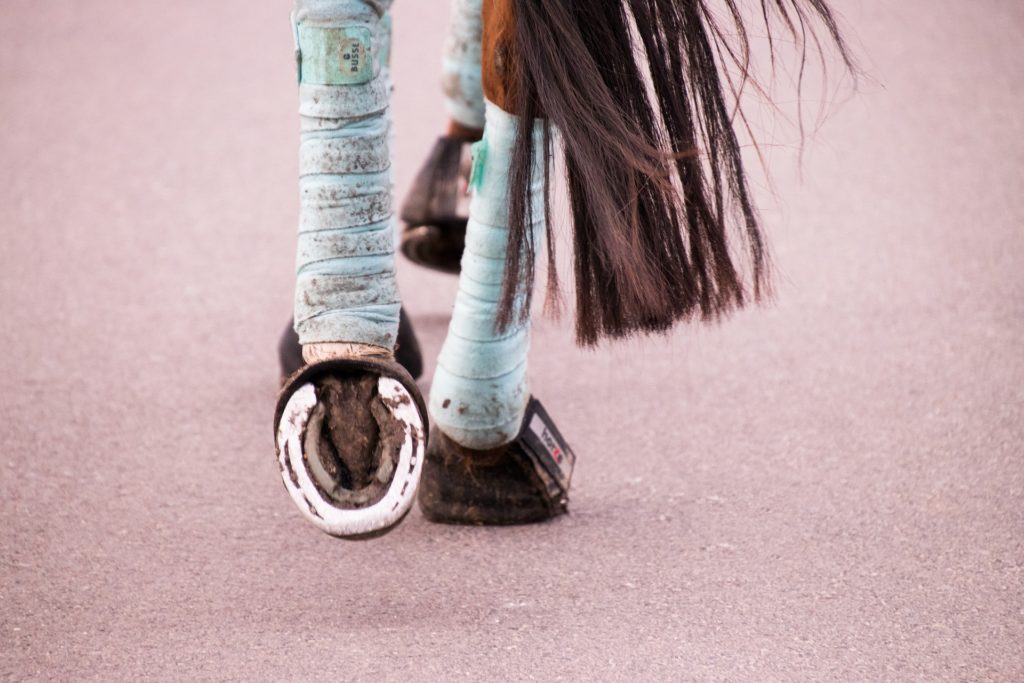
Bête noire de tout cavalier, notamment de sport, la tendinite est souvent synonyme d’une longue période de convalescence et rééducation. A moins qu’elle ne soit trop importante et arrête définitivement la carrière d’un cheval.
Reconnue comme l’une des blessures les plus courantes dans les sports équestres, nous allons vous expliquer, à travers l’expérience d’une utilisatrice, comment il est possible de suspecter cette atteinte avant que les réels symptômes (boiterie, engorgement chaud et douloureux) ne se manifestent. Attention, dans le cas que vous allez découvrir, il s’agissait d’une lésion de fatigue. Seaver ne peut malheureusement pas encore anticiper tous les types de lésions ou de contextes dans lesquels surviennent la blessure. Votre sangle (ou protège-sangle) sera utile en appui au protocole du vétérinaire pour la rééducation et identifier des possibles douleurs post-traumatiques.
Rappelons dans un premier temps que les tendons sont des structures fibreuses jouant un rôle d’amortisseur entre les muscles et les os. Peu vascularisés et peu extensibles, ils sont vus comme un des maillons faibles de l’appareil locomoteur chez les chevaux.
Comme chez nous, la tendinite est une rupture partielle ou totale des fibres de collagène composant le tendon. La tendinite est souvent détectée à un stade nécessitant le repos, pouvant aller entre 3 à 15 mois en fonction de la pathologie. Un engorgement, plus ou moins chaud, avec une sensibilité à la palpation ainsi qu’une boiterie plutôt sur des sols dits « mous » caractérisent la tendinite. Le vétérinaire établit son diagnostic à l’aide d’un examen clinique et d’une échographie. La carrière sportive dépend donc de la gravité de la lésion et des tissus impactés. Mais égalementet surtout du respect des soins et de la rééducation préconisés.
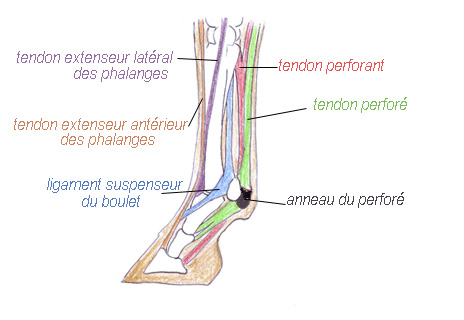
Le problème lorsque survient une telle lésion, c’est sa possible récidive… Le tissu cicatriciel n’est pas le tissu originel. Bien que plus solide, il est encore moins élastique et la zone de transition entre ces deux tissus est fragile. Il faut alors éloigner au mieux ce possible risque de nouvelle blessure. Il est donc important d’effectuer un suivi et des soins réguliers après des efforts.
A ce jour, pas de remède miracle malheureusement. Cependant quelques facteurs importants à prendre en compte peuvent vous aider à en limiter le risque :
Sachez par ailleurs qu’il existe 3 types d’origine de lésions tendineuses :
Avec une utilisation régulière et une attention particulière aux données récoltées ainsi qu’à la condition générale de votre cheval, la technologie Seaver peut vous aider à anticiper les lésions dites de « fatigue ». Pour les deux autres typologies de lésions, votre capteur vous accompagne dans la détection d’efforts inadaptés et/ou de douleur de votre cheval.
Juliette est la propriétaire d’une jument de sport de 8 ans qui évolue sur des épreuves CSO 1m30-1m35. Elle l’a acquise à ses 3 ans. Juliette a toujours porté une attention particulière à sa condition physique et à son bien-être. C’est pour cela qu’elle s’est tournée vers le protège-sangle Seaver. Ce dernier lui permet d’avoir un suivi et une compréhension plus précise de sa jument.
L’utilisation du protège-sangle date de juillet et ce dernier est utilisé pour chacune des sorties de la jument, même en travail à la longe. De ce fait, Juliette dispose de données moyennes concernant le cardio, la symétrie au trot, le rebond, …
Les données qu’elle regarde cependant le plus sont le cardio et la symétrie au trot. Voici par exemple les données de symétrie qu’elle nous a fournies après son premier mois d’utilisation :
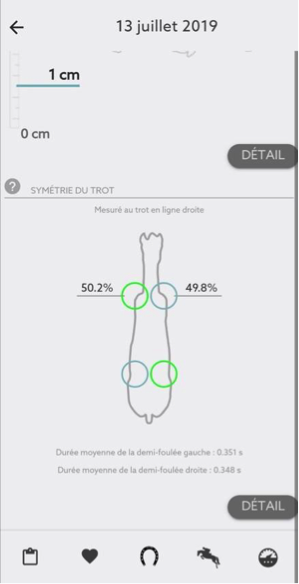
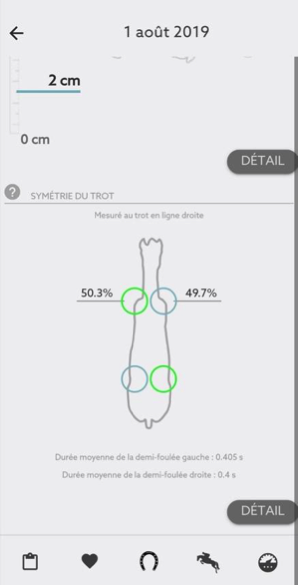
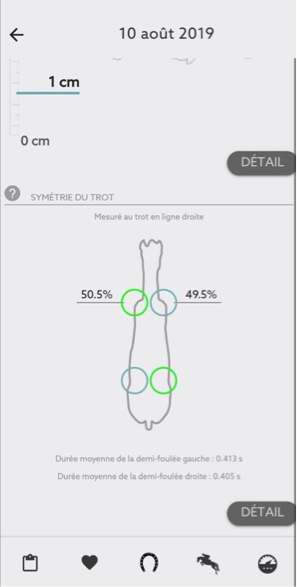
On peut donc voir que les données sont régulières et constantes. C’est à partir du 11 août que débute l’interrogation de la cavalière. Cela fait suite à un léger changement d’équilibre entre les deux bipèdes diagonaux :
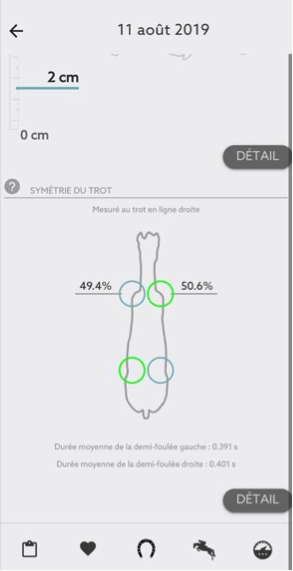
Rien d’alarmant mais cette utilisatrice nous a confié être très attentive aux détails. Elle a donc décidé de faire une semaine en alternant un travail léger monté et des journées de repos au paddock.
Une semaine plus tard, elle a demandé à un cavalier professionnel de monter sa jument. Elle voulait voir si les données de la semaine passée étaient à prendre en considération ou pas. Et c’était effectivement sûrement le cas :
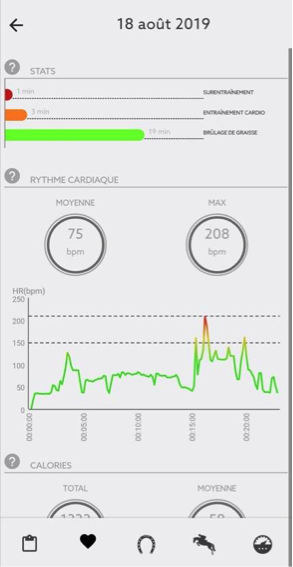
Après une longue période au pas, le cavalier a décidé de prendre le trot. Mais la jument quant à elle a décidé de prendre le galop à droite. Immédiatement, Juliette a vu que quelque chose n’allait pas dans la réaction de sa jument lors du départ. Elle a donc demandé au cavalier de repasser au pas et de rester là-dessus. La lecture du graphique ci-dessus montre un pic de cardio correspondant au moment de la prise de galop.
Une fois de retour aux écuries, la jument est contrôlée par Juliette et son cavalier qui ne détectent aucune douleur, aucune grosseur, aucune boiterie (sur sol dur et mou). La jument au travail se montrait comme à son habitude très « guerrière ».
Le cavalier a continué de travailler la jument les jours suivants de manière très légère. Toujours aucun signe d’une possible pathologie ne sont apparus. Ce sont les données de la symétrie au trot ainsi que le cardio montrant dans un premier temps des valeurs importantes lors du galop à droite puis sur la séance du lendemain des chiffres élevés au trot et très élevés au galop qui ont été le signal d’alarme pour appeler le vétérinaire pour un contrôle :
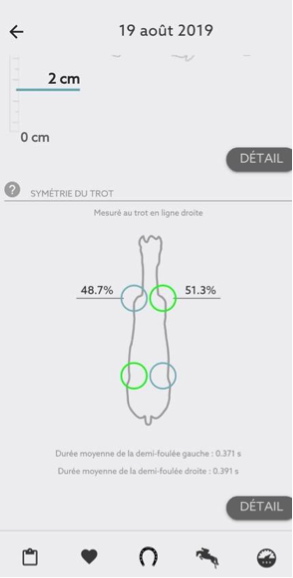
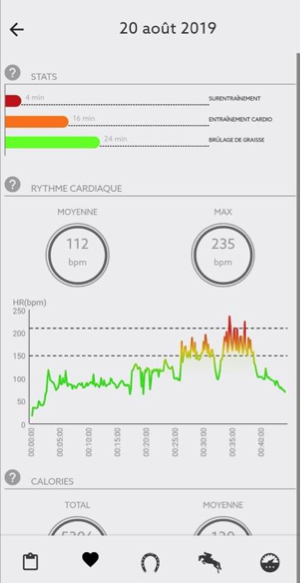
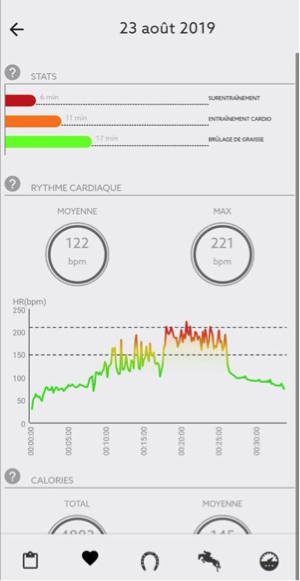
Juliette nous a bien précisé qu’à l’appel du vétérinaire, sa jument ne présentait aucun signe de lésion tendineuse : pas de boiterie, pas d’engorgement, pas de douleur au toucher, une jument inchangée dans son comportement. En attendant la venue du vétérinaire, pas en main et broutage d’herbe ont été au programme, avec comme soins la pose simple de bandes de repos aux antérieurs (suspicion de la blessure au niveau de l’antérieur droit aux vues de données précédentes).
Le jour de la venue du vétérinaire, horreur : en enlevant les bandes, l’antérieur droit est très engorgé et douloureux. Le vétérinaire arrivera quelques minutes plus tard en le constatant aucune boiterie sur sols durs et mous, seulement ce qui a déjà été perçu par Juliette en enlevant les bandes.
C’est au tour de l’échographie de rentrer en jeu… Après de nombreuses minutes de recherche pour essayer de trouver la cause, qui semble bien être une lésion tendineuse, le diagnostic est prononcé : une microlésion du suspenseur de l’antérieur droit. Le vétérinaire préconise 3 semaines de pas avec des bandes de repos aux antérieurs, accompagnées par une lotion aux plantes anti-inflammatoire. Une reprise progressive du travail par la suite avec échographie de contrôle après la convalescence au pas. Le vétérinaire n’est pas inquiet, il ne parle pas vraiment de réelle tendinite étant donné la précocité de détection, dont il a été agréablement surpris.
Bien qu’on préfère tous avoir un cheval en bonne santé, Juliette a été ravie de ce diagnostic car sans Seaver, elle aurait continué à travailler sa jument normalement, en lui demandant des efforts qui l’auraient poussée certainement à une blessure plus profonde et donc avec au minimum 3 mois d’arrêt suivis d’une période de rééducation. Depuis, la jument a repris le travail et la prise en charge rapide de ce début de lésion permet d’alléger les risques d’une nouvelle blessure.
Grâce à ce retour utilisateur, l’utilisation régulière de votre produit Seaver peut en effet vous aider à prévenir certains types de blessures que l’on souhaite éviter et qui sont malheureusement très courantes chez les chevaux de sport.
N’hésitez pas à nous faire parvenir également vos retours quant à l’utilisation de votre Seaver ☺
See you soon,
l’équipe Seaver